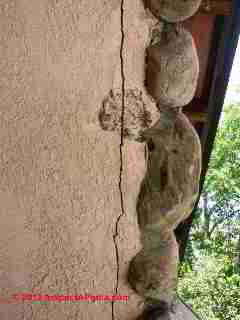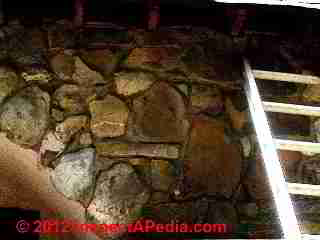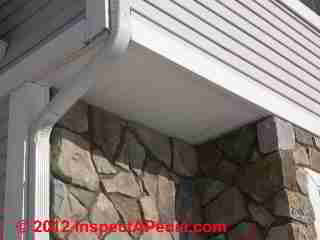 Stone Veneer Walls: stone facing construction, leaks, repairs
Stone Veneer Walls: stone facing construction, leaks, repairs
- POST a QUESTION or COMMENT about troubleshooting & repairing loose or leaky stone veneers on buildings
Stone veneer walls:
This article describes how to troubleshoot & repair stone veneer walls on buildings: a stone "skin" placed over masonry or wood framing: the construction, inspection, troubleshooting & repair of stone veneer walls on buildings, including loose, cracking or bulging stone veneers, water leaks through and behind the stone, waterproofing of stone veneers, and the use of drainage and moisture membranes in stone veneer construction.
InspectAPedia tolerates no conflicts of interest. We have no relationship with advertisers, products, or services discussed at this website.
- Daniel Friedman, Publisher/Editor/Author - See WHO ARE WE?
Stone Veneer Walls on Buildings - Diagnosing Leaks, Loose, Bulging
Traditional Stone Veneer Walls on Masonry - loose, falling due to leaks
 Our page top photo illustrates very serious damage to what had been a beautiful stone veneer installed on a masonry building at the Mills Mansion in Dutchess County, New York in the U.S.
Our page top photo illustrates very serious damage to what had been a beautiful stone veneer installed on a masonry building at the Mills Mansion in Dutchess County, New York in the U.S.
Lack of maintenance on this building included allowing roof drainage to run down the building wall instead of into a gutter and downspout system.
The combination of water penetration behind the veneer and freezing winter weather have led to the bulge shown at page top, and complete loss of stone veneer and trim in our second photo at left.
This building was a solid masonry stone structure with stone veneer adhered to a rubble-stone wall (shown at left).
Modern Stone Veneer Wall Loose, Bulged, Cracked at Sides
Our stone veneer wall photo (left) illustrates where you can easily spot a stone veneer wall on a modern building and where there is evidence of bulging in the veneer.
This vertical crack between the stone veneer itself and the structural wall behind it is found at building corners (or at garage door openings) where there is a transition between stone veneer and other building wall coverings.
The causes of this cracking and bulging are typically
Omission of proper or an adequate number of fasteners binding the veneer to the building structural wall
Water damage to the stone work or to the structural wall behind it
In some designs, omission of an adequate, supporting ledger at the bottom of the veneer wall intended to help carry its weight.
Repairs of a loose stone veneer may be possible without complete disassembly and replacement, using add-on fasteners that are sold for brick or stone wall veneer retrofit work.
See BRICK VENEER WALL Loose, Bulged for sources of repair connectors for loose masonry veneers.
Modern Stone Veneer Walls - stone over wood framing - leaks lead to rot
 Our modern stone veneer wall photo (left) illustrates how hidden leaks behind a poorly-built structure can fool the casual observer.
Our modern stone veneer wall photo (left) illustrates how hidden leaks behind a poorly-built structure can fool the casual observer.
This wall looks just fine from outside, but an investigation (of a mold complaint) in the building interior, combined with some strategic test cuts, discovered a history of water leaks behind and through the stone veneer since the time of original construction.
The leaks in this wall originated at the top of the veneer that had not been properly sealed nor flashed at the bottom of the second floor wall and trim (red arrow). We looked for additional leaks around the windows as well (blue arrow).
Mortar between the stone veneer components was also used to "seal" at the veneer-wall top and around the windows where differences in materials (flexibility, rates of thermal expansion) left leaky openings.
This house was less than ten years old and had already suffered serious damage.
Water ran down the wall cavity, soaking insulation, rotting sheathing, and leading to a costly mold cleanup job.
Hidden Damage at Leaky Stone Veneers
We took advantage of the extensive building demolition necessary for repair of a home following a fire to take this photo (left) of rot and water stains in the wall cavity of a home similar to the one shown above.
This is the type of damage that occurs at any wood-framed building wall that suffers un-attended leaks for several years or more.
Water had leaked into this wall cavity for more than a decade, leading to rotted sheathing and ultimately, a carpenter ant infestation at the wall sills and lower framing.
Water Leaks at Joints in Stone Veneers on Buildings
Water can leak through a stone veneer wall just about anywhere, even under a roof overhang (photo at left) when a storm produces blowing rain.
Look for:
- Visible cracks between the stone and its surrounding mortar
- Loose individual stones
- Horizontal joints (red arrows) that trap water or even direct it into the building, particularly on stones whose upper edge is roughly horizontal and that may actually slope "inwards" towards the building wall cavity.
Procedures for Installing a Successful Stone Veneer Walls on Buildings
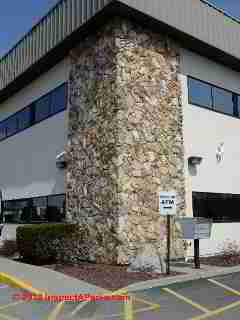 This stone veneer wall (HVFCU, Poughkeepsie, NY) does not appear to have become loose or leaky since installation. Features of a successful stacked stone, fake stone, or cultured stone veneer include: adapting and expanding on advice from Sakrete®:[9]
This stone veneer wall (HVFCU, Poughkeepsie, NY) does not appear to have become loose or leaky since installation. Features of a successful stacked stone, fake stone, or cultured stone veneer include: adapting and expanding on advice from Sakrete®:[9]
- Moisture barrier behind stone veneers:
Installation of a moisture barrier (and drainage plane) on the building structural wall before the stone work begins; - Stone veneer support: Installation of a support system for the stone: expanded metal lath or masonry ties, installed over the moisture barrier
- Mortar choice & application:
Mortar: Choice of proper stone mortar (Sakrete® recommends Type S Mortar), properly mixed (don't use too much water)
A scratch coat is followed by a finish coat of mortar onto which stones are placed and tied. Each stone is set in place with a twisting motion to set it into the mortar.
Be sure the back surface of the stone is clean - dirt can interfere with bonding between the stone and the mortar. - Stone veneer layout:
Stones are laid-out on the ground and arranged in a suitable pattern before beginning construction.
Place each stone as it would lie naturally in nature - generally with its heavy or longer side "down" - don't place a stone upside down, resting on its "point" nor with its long axis running vertically - your wall veneer will not look "right" when it's finished if you make stone placement mistakes.
Observers may find the wall pleasing or not, without quite knowing why, but often it's because of just how stones are placed to look natural. If necessary, stones can be re-shaped or cut to fit using a masonry hammer and a brick chisel. (Wear eye protection). - Stone veneer placement for drainage:
Do not place a stone onto the wall with an upper edge that slopes "in" towards the wall interior. Flip such stones over so that water that falls on the top edge of the stone tends to run out away from the wall interior. - Final pointing (tuckpointing):
When stones are all set, tuck point mortar between the stones or use a grout bag (like a cake icing bag) to get the mortar into the stone joints.
Fix Leaks in Stone Veneer Walls
 Reader Question: how can I drain a leaky stone veneer wall from outside?
Reader Question: how can I drain a leaky stone veneer wall from outside?
I am an indoor air specialist in the Faroe Islands, and I have a stone building with water in between two walls (Sandwich Walls)
I need some literature on the subject, how can i drain these walls from the outside?
There have been ventilation holes, in the outer stone walls in between stones, but they are now sealed, and no ventilation are in between the walls at all.
I have send you pictures from the outside and from the inside of the building.
I hope you can help me. Best Regards, Lone Grønborg, Inniluft Tænastan, Faroe Islands. Email: ilt@ilt.fo [10]
Reply: first diagnose the cause of stone wall leaks, second check for hidden damage, third add drainage of proper size and at right location
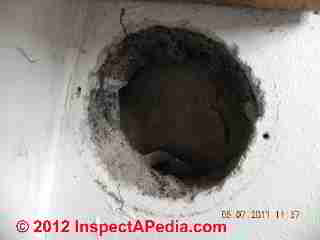 Thank you for the interesting question - it helps us realize where we need to work on making our text more clear or more complete.
A competent onsite inspection by an expert usually finds additional clues that help accurately diagnose a problem with moisture trapped in a building wall. That said, here are some things to consider:
Thank you for the interesting question - it helps us realize where we need to work on making our text more clear or more complete.
A competent onsite inspection by an expert usually finds additional clues that help accurately diagnose a problem with moisture trapped in a building wall. That said, here are some things to consider:
It is indeed difficult to construct a stone veneer wall that is waterproof.
For this reason, as with some brick veneer walls the traditional stone veneer wall is often constructed with a cavity between it and the building structural wall that in turn may be built of wood or masonry.
Water that enters the wall is supposed to drain down in the wall cavity and exit at the veneer wall bottom, outside, without entering the building.
Modern stone veneer walls are typically installed without a drainage cavity but over a moisture barrer.
See details
at BRICK WALL DRAINAGE WEEP HOLES.
Climate factors for Stone Veneer Walls in the Faroe Islands
Your wall appears to be the first type. Because of your location (the Faroe Islands) your home is probably exposed to severe storms that brew in the North Atlantic, and while you may not be exposed to frost damage in a leaky stone veneer wall, the wall is likely to be exposed to powerful wind-blown rain, making its design and drainage extra important.
Adequacy of original stone veneer wall drainage
Your photo above shows what looks like a small diameter pipe in a stone veneer or stone wall mortar joint at an un-specified height above the wall bottom, but certainly not at the wall bottom. There is no pattern or stain suggesting that this particular opening has been draining water.
Your second stone wall photo (above left) appears to be a test cut opening showing the cavity space between wall cavities.
Diagnose the stone veneer wall leaks first
Before even trying to "drain" water from the wall in your photos we need to accurately diagnose where the water is coming from and how the original wall intended the water to either be kept out or drained from the wall; otherwise your solution may not properly match the problem nor the wall design.
Our photos and text above illustrate common leak points in stone veneer wall installations.
Some masonry veneer walls such as a stone veneer over wood framing, are not intended to leak into the structure. Those walls typically lack a drainage system entirely. Leaks in such walls are fixed by finding the points of water entry (say wind blown rain at cracks around stones) and sealing them - a difficult task.
Other veneer walls, such as brick veneer, and some stone veneer walls, perhaps yours, are designed with a cavity between the stone facing and the interior wall, a water barrier over the inner structural wall sheathing, and drainage openings at the wall bottom.
Those walls can begin to have a water problem when falling debris in the wall (or insects from outside) block the drain openings.
How to Repair Leaky or Loose Stone Veneers
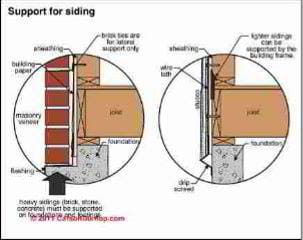 Take heart: it's rare that any of us encounters a building problem that has not arisen before, and often there is a well-designed solution that can be found by a little digging.
Take heart: it's rare that any of us encounters a building problem that has not arisen before, and often there is a well-designed solution that can be found by a little digging.
Carson Dunlop Associates' sketch (left) is of a brick veneer wall, not stone, but the same principles apply to your wall as shown in the masonry veneer shown in the left side of the sketch.
See BRICK WALL DRAINAGE WEEP HOLES for a description of this problem and retrofit products that can be used for additional drain openings.
In general we focus on securing the stone veneer if it's loose, looking for and sealing exterior leaks, and making darn sure that the wall cavity has functional drainage. And we might investigate further for hidden water damage.
More dramatic approaches such as wall reconstruction over a water barrer would be an expensive last resort.
For a stone veneer wall such as the one in your photos I would
- Inside inspection:
Inspect by eye and perhaps by a moisture meter if you can obtain or build one - to identify where water may be entering and perhaps damaging the structure (rot, mold) and I might even make a test cut inside at the most-suspect area to check for damage and to decide if further work is needed on the wall structure. - Outside inspection:
Inspect by eye outside for sources of water leakage - loose stones for example - that need repair. See our troubleshooting photos and examples in the article above. - Clear existing veneer wall drains:
Based on where moisture or water seems most severe, at appropriate wall bottom areas, I would probe to clear out existing drain openings and if necessary drill and add openings at exactly the right locations in mortar joints at the bottom of stones in the leak area; - Add needed veneer wall drains:
Locate the stone veneer wall drain openings at the bottom of the wall; higher drains typically don't do much. Make new drain openings at least as wide as the mortar joint - Screen stone veneer wall drains:
Cover them with screening to keep out rodents or insects who otherwise will clog the opening. - Ventilation in the veneer wall cavity,
as you mention in your note, is probably less important than adequate drainage to let any leakage out of the wall, along with sealing any water entry points that you can.
In some climates ventilation behind a masonry veneer wall may actually be harmful, drawing warm moist air into the wall cavity (during your short warm months) where it condenses and adds to the moisture load.
Watch out: for loose masonry veneer that may need repair, replacement, or securing to the structure. (Add-on wall ties to secure loose masonry are also available or can be fabricated if they're not readily available to you.
See BRICK VENEER WALL for more examples.
Stone Veneer Repair Research
- Mack, Robert C., FAIA & Anne E. Grimmer, ASSESSING CLEANING AND WATER-REPELLENT TREATMENTS FOR HISTORIC MASONRY BUILDINGS [PDF] (2000) U.S. National Park Service, Technical Preservation Services, retrieved 2022/10/02 original source: https://www.nps.gov/tps/how-to-preserve/briefs/1-cleaning-water-repellent.htm
- Mack, Roberty C., FAIA & John P. Speweik, REPOINTING MORTAR JOINTS IN HISTORIC MASONRY BUILDINGS [PDF] (1998) U.S. National Park Service, Technical Preservation Services, retrieved 2022/10/02 original source: https://www.nps.gov/tps/how-to-preserve/briefs/2-repoint-mortar-joints.htm
...
Reader Comments, Questions & Answers About The Article Above
Below you will find questions and answers previously posted on this page at its page bottom reader comment box.
Reader Q&A - also see RECOMMENDED ARTICLES & FAQs
On 2020-06-15 - by (mod) -
Sure, Helen,
You are welcome to post a question
On 2020-06-15 by Helen
Need help
On 2017-09-17 by (mod) -water ran down our chimney and caused dampness and efflorescence
Gayle,
Be sure that you have a proper rain cap on the chimney top and that the top of the flue is properly sealed.
See CHIMNEY REPAIRS, TOP & CLAY FLUE TILE - https://inspectapedia.com/chimneys/Chimney_Top_Tile_Repairs.php
and also CHIMNEY CAP & CROWN DEFINITIONS https://inspectapedia.com/chimneys/Chimney_Caps_Tops.php for clarification of the distinction between the rain cap and the top seal around the flue.
The efflorescence you describe will continue to appear until all of the masonry components are quite dry - that can take a month or more.
Once there is no more high moisture AND IF there are no ongoing leaks, then cleaning off the surfaces of stone where you saw efflorescence will be sufficient. A simple dilute vinegar solution would work as would most household cleaners.
For a more thorough understanding of efflorescence, we have a series of articles starting
at EFFLORESCENCE SALTS & WHITE DEPOSITS -
https://inspectapedia.com/Wet_Basements/Efflorescence-White.php
that would be helpful. I'd welcome any further questions that occur to you after looking at that or any of our articles.
If you continue to see new leak stains then I'd suspect that there is an ongoing water entry point that hasn't been found.
At CHIMNEY STAINS & LEAKS https://inspectapedia.com/chimneys/Chimney_Stains_Leaks.php we describe tracking those down.
On 2017-09-17 by Gayle
We have had a new roof installed and chimney repaired. Those problems caused water to run down our chimney and caused dampness and efflorescence to occur on our stacked stone fireplace.
The rocks affected have turned a darker color than the rest of the rock. Since our problem seems to have been fixed(hopefully) what can we do to dry out the discolored rocks. Thank you.
On 2017-08-07 by (mod) - where to start in repairing chipped stone veneer wall
Joan,
There are masonry as well as epoxy repair materials and kits, even some sealants, that can repair chips in a stone veneer wall, but before trying to make a choice of the best chipped stone repair material and process we need to know what is the actual material on your home.
Is it actually stone, concrete embossed to resemble stone, fiberglass, synethtic stone, asphalt or something else?
We need to select a compatible patch material, then we can discuss matching the stone veneer colour and texture.
On 2017-08-07 by JoanSees
Hi--How can I repair the Veneer Chipped Stone on my home?
On 2017-04-28 - by (mod) -
Vicki,
I don't know, and can't see the wall from here (in the U.K.) but perhaps if you're in a freezing climate, spalling from frost damage;
Take a look at the area of pitting to look for a location or pattern that might suggest a cause: rain splash-up off of a roof, for example.
On 2017-04-27 by Vicki Gulley
What are the round pits on the cultured stone porch wall?
On 2017-02-11 by Hoang
We are looking at a Triplex built in 1900 ish, with a Stone facade
The joints between the stones have mostly turn to 'dust',
and a long screwdriver 5" goes all the way in.
Here is the concern: the wall bows out about 3" in the middle of the wall for about 8' and more
Our inspector mentioned that a Wall is declared 'Fail' if it inches out 1/3 or more of the stone thickness
Please comment
On 2017-01-27 - by (mod) -
Candace
Your question presumes part of its answer: that a water blocking agent was omitted between concrete block and stone veneer.
I'd agree that it is common for there to be water penetration through a stone veneer and that unless there is either a perfect seal over the building wall or a drainage system installed behind the veneer leaks may be a problem.
At this point I'd focus on finding the points of entry, typically along the upper side or perhaps vertical edges of stones, and sealing those.
On 2017-01-26 by Candace
When my house was built, stone was applied to bare concrete blocks without the use of a water blocking agent.
Also, the mortar was applied to the back of the stones but not in between. Now that I know this, what can I do to prevent storm water from infiltrating the walls and producing mold?
On 2015-07-16 by Anonymous (mod)
Sorry I don't understand the question.
You are installing stone veneer on what: a wall, floor, ceiling?
What do you mean by "upside down" - do you mean you want to expose the back side of the stone veneer pieces?
On 2015-07-16 by williamsdon51@yahoo
Can i install stone veneer upsidedown in an entry way
...
Continue reading at BRICK VENEER WALL LOOSE, BULGED or select a topic from the closely-related articles below, or see the complete ARTICLE INDEX.
Or see these
Recommended Articles
- ASBESTOS CEMENT SIDING
- BRICK VENEER WALL
- BRICK VENEER WALL AIR LEAKS
- BRICK VENEER WALL LOOSE, BULGED
- BRICK VENEER WALL REPAIR CODES & STANDARDS
- BRICK WALL DRAINAGE WEEP HOLES
- BRICK WALL INSULATION RETROFIT
- BRICK WALL THERMAL EXPANSION CRACKS
- BRICK WALL WOOD NAILER INSERTS
- GRAFFITI REMOVAL FROM BRICK CONCRETE STONE SURFACES
- PERMA-STONE EXTERIORS - faux stone siding
- STAINS on BRICK SURFACES
- STAINS on CONCRETE
- STAINS on SANDSTONE, DIAGNOSE & CURE
- STAINS on STONE, STUCCO DIAGNOSE & CURE
- STONE, STUCCO & BRICK CLEANING METHODS
- STONE VENEER WALLS
Suggested citation for this web page
STONE VENEER WALLS at InspectApedia.com - online encyclopedia of building & environmental inspection, testing, diagnosis, repair, & problem prevention advice.
Or see this
INDEX to RELATED ARTICLES: ARTICLE INDEX to EXTERIORS of BUILDINGS
Or use the SEARCH BOX found below to Ask a Question or Search InspectApedia
Ask a Question or Search InspectApedia
Questions & answers or comments about ...
Try the search box just below, or if you prefer, post a question or comment in the Comments box below and we will respond promptly.
Search the InspectApedia website
Note: appearance of your Comment below may be delayed: if your comment contains an image, photograph, web link, or text that looks to the software as if it might be a web link, your posting will appear after it has been approved by a moderator. Apologies for the delay.
Only one image can be added per comment but you can post as many comments, and therefore images, as you like.
You will not receive a notification when a response to your question has been posted.
Please bookmark this page to make it easy for you to check back for our response.
IF above you see "Comment Form is loading comments..." then COMMENT BOX - countable.ca / bawkbox.com IS NOT WORKING.
In any case you are welcome to send an email directly to us at InspectApedia.com at editor@inspectApedia.com
We'll reply to you directly. Please help us help you by noting, in your email, the URL of the InspectApedia page where you wanted to comment.
Citations & References
In addition to any citations in the article above, a full list is available on request.
- [1] Steven Bliss served as editorial director and co-publisher of The Journal of Light Construction for 16 years and previously as building technology editor for Progressive Builder and Solar Age magazines. He worked in the building trades as a carpenter and design/build contractor for more than ten years and holds a masters degree from the Harvard Graduate School of Education. Excerpts from his recent book, Best Practices Guide to Residential Construction, Wiley (November 18, 2005) ISBN-10: 0471648361, ISBN-13: 978-0471648369, appear throughout this website, with permission and courtesy of Wiley & Sons. Best Practices Guide is available from the publisher, J. Wiley & Sons, and also at Amazon.com .
- [3] Masonry Design & Detailing, Christine Beall, McGraw-Hill 4th Ed. (1997), ISBN 007005844X ISBN 978-0070058446
- [4] The Stonebuilder's Primer: A Step-By-Step Guide for Owner-Builders, Charles Long, Firefly Books, Revised 1998, ISBN: 978-1552092989
- [5] Dimension Stone Cladding: Design, Construction, Evaluation, and Repair (Astm Special Technical Publication//Stp, 1394.), ASTM International, 2000, ISBN: 978-0803128750
- [6] The Complete Guide to Building With Rocks & Stone: Stonework Projects and Techniques Explained Simply (Back-To-Basics), Brenda Flynn, Atlantic Publishing Group (2011), ISBN 978-1601383709
- [7] Modern Stone Cladding: Design and Installation of Exterior Dimension Stone Systems (ASTM Manual Series),
- [8] Cultured Stone Veneer Ashlar Bond with Steven W. Kelley, [DVD] 2010, 29 minutes.
- [9] "Installing Stone Veneer", Sakrete®, web search 3/20/2012, original source: http://www.sakrete.com/uploads/projects/Sakrete_Stone_Veneer_Mortar_how_to.pdf, [copy on file as /exterior/Sakrete_Stone_Veneer_Mortar_how_to.pdf] Contact Sakrete at Tel: 866-SAKRETE or 800-548-4033.
Technical review requested 3/20/2012. - [10] Lone Grønborg, Inniluft Tænastan, Faroe Islands. Email: fbanalyse@gmail.com Mr. Grønborg is an indoor air quality specialist in the Faroe Islands. His website and illustrations of some cases he has investigated can be viewed at http://www.ilt.fo/ Contact: Kontakt os på tlf: 58 30 40
- In addition to citations & references found in this article, see the research citations given at the end of the related articles found at our suggested
CONTINUE READING or RECOMMENDED ARTICLES.
- Carson, Dunlop & Associates Ltd., 120 Carlton Street Suite 407, Toronto ON M5A 4K2. Tel: (416) 964-9415 1-800-268-7070 Email: info@carsondunlop.com. Alan Carson is a past president of ASHI, the American Society of Home Inspectors.
Thanks to Alan Carson and Bob Dunlop, for permission for InspectAPedia to use text excerpts from The HOME REFERENCE BOOK - the Encyclopedia of Homes and to use illustrations from The ILLUSTRATED HOME .
Carson Dunlop Associates provides extensive home inspection education and report writing material. In gratitude we provide links to tsome Carson Dunlop Associates products and services.


